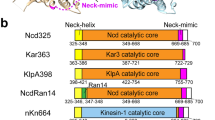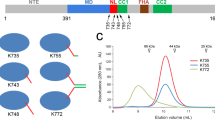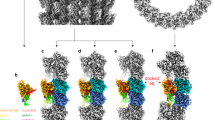Abstract
Kinesins are molecular motors that require a divalent metal ion (for example, Mg2+) to convert the energy of ATP hydrolysis into directed force production along microtubules. Here we present the crystal structure of a recombinant kinesin motor domain bound to Mn2+ and ADP and report on a serine-to-cysteine substitution in the switch 1 motif of kinesin that allows its ATP hydrolysis activity to be controlled by adjusting the ratio of Mn2+ to Mg2+. This mutant kinesin binds ATP similarly in the presence of either metal ion, but its ATP hydrolysis activity is greatly diminished in the presence of Mg2+. In human kinesin-1 and kinesin-5 as well as Drosophila melanogaster kinesin-10 and kinesin-14, this defect is rescued by Mn2+, providing a way to control both the enzymatic activity and force-generating ability of these nanomachines.
This is a preview of subscription content, access via your institution
Access options
Subscribe to this journal
Receive 12 print issues and online access
$189.00 per year
only $15.75 per issue
Buy this article
- Purchase on Springer Link
- Instant access to full article PDF
Prices may be subject to local taxes which are calculated during checkout





Similar content being viewed by others
References
Saraste, M., Sibbald, P.R. & Wittinghofer, A. The P-loop—a common motif in ATP- and GTP-binding proteins. Trends Biochem. Sci. 15, 430–434 (1990).
Vale, R.D. Switches, latches, and amplifiers: common themes of G proteins and molecular motors. J. Cell Biol. 135, 291–302 (1996).
Marx, A., Muller, J. & Mandelkow, E. The structure of microtubule motor proteins. Adv. Protein Chem. 71, 299–344 (2005).
Frederiksen, J.K. & Piccirilli, J.A. Identification of catalytic metal ion ligands in ribozymes. Methods 49, 148–166 (2009).
Piccirilli, J.A., Vyle, J.S., Caruthers, M.H. & Cech, T.R. Metal ion catalysis in the Tetrahymena ribozyme reaction. Nature 361, 85–88 (1993).
Warnecke, J.M. et al. Ribonuclease P (RNase P) RNA is converted to a Cd2+-ribozyme by a single Rp-phosphorothioate modification in the precursor tRNA at the RNase P cleavage site. Proc. Natl. Acad. Sci. USA 93, 8924–8928 (1996).
Peracchi, A., Beigelman, L., Scott, E.C., Uhlenbeck, O.C. & Herschlag, D. Involvement of a specific metal ion in the transition of the hammerhead ribozyme to its catalytic conformation. J. Biol. Chem. 272, 26822–26826 (1997).
Sontheimer, E.J., Sun, S. & Piccirilli, J.A. Metal ion catalysis during splicing of premessenger RNA. Nature 388, 801–805 (1997).
Sarnovsky, R.J., May, E.W. & Craig, N.L. The Tn7 transposase is a heteromeric complex in which DNA breakage and joining activities are distributed between different gene products. EMBO J. 15, 6348–6361 (1996).
Allingham, J.S., Pribil, P.A. & Haniford, D.B. All three residues of the Tn 10 transposase DDE catalytic triad function in divalent metal ion binding. J. Mol. Biol. 289, 1195–1206 (1999).
Gao, K., Wong, S. & Bushman, F. Metal binding by the D, DX35E motif of human immunodeficiency virus type 1 integrase: selective rescue of Cys substitutions by Mn2+in vitro. J. Virol. 78, 6715–6722 (2004).
Jaffe, E.K. & Cohn, M. Diastereomers of the nucleoside phosphorothioates as probes of the structure of the metal nucleotide substrates and of the nucleotide binding site of yeast hexokinase. J. Biol. Chem. 254, 10839–10845 (1979).
Cochran, J.C. & Gilbert, S.P. ATPase mechanism of Eg5 in the absence of microtubules: insight into microtubule activation and allosteric inhibition by monastrol. Biochemistry 44, 16633–16648 (2005).
Cochran, J.C. et al. ATPase cycle of the nonmotile kinesin NOD allows microtubule end tracking and drives chromosome movement. Cell 136, 110–122 (2009).
Parke, C.L., Wojcik, E.J., Kim, S. & Worthylake, D.K. ATP hydrolysis in Eg5 kinesin involves a catalytic two-water mechanism. J. Biol. Chem. 285, 5859–5867 (2010).
Reed,, G.H. & Markham,, G.D. EPR of Mn(II) Complexes with enzymes and other proteins. in Biological Magnetic Resonance (eds. Berliner, L.J.& Reuben, J.) 73–142 (Plenum, New York, 1984).
Leonard, M., Song, B.D., Ramachandran, R. & Schmid, S.L. Robust colorimetric assays for dynamin's basal and stimulated GTPase activities. Methods Enzymol. 404, 490–503 (2005).
Brune, M., Hunter, J.L., Corrie, J.E. & Webb, M.R. Direct, real-time measurement of rapid inorganic phosphate release using a novel fluorescent probe and its application to actomyosin subfragment 1 ATPase. Biochemistry 33, 8262–8271 (1994).
Woehlke, G. et al. Microtubule interaction site of the kinesin motor. Cell 90, 207–216 (1997).
Fisher, A.J. et al. X-ray structures of the myosin motor domain of Dictyostelium discoideum complexed with MgADP·BeFx and MgADP·AlF4−. Biochemistry 34, 8960–8972 (1995).
Pai, E.F. et al. Refined crystal structure of the triphosphate conformation of H-ras p21 at 1.35 Å resolution: implications for the mechanism of GTP hydrolysis. EMBO J. 9, 2351–2359 (1990).
Shah, K., Liu, Y., Deirmengian, C. & Shokat, K.M. Engineering unnatural nucleotide specificity for Rous sarcoma virus tyrosine kinase to uniquely label its direct substrates. Proc. Natl. Acad. Sci. USA 94, 3565–3570 (1997).
Bishop, A.C. et al. Design of allele-specific inhibitors to probe protein kinase signaling. Curr. Biol. 8, 257–266 (1998).
Shogren-Knaak, M.A., Alaimo, P.J. & Shokat, K.M. Recent advances in chemical approaches to the study of biological systems. Annu. Rev. Cell Dev. Biol. 17, 405–433 (2001).
Specht, K.M. & Shokat, K.M. The emerging power of chemical genetics. Curr. Opin. Cell Biol. 14, 155–159 (2002).
Reddi, A.R., Jensen, L.T. & Culotta, V.C. Manganese homeostasis in Saccharomyces cerevisiae. Chem. Rev. 109, 4722–4732 (2009).
Bauer, C.B., Holden, H.M., Thoden, J.B., Smith, R. & Rayment, I. X-ray structures of the apo and MgATP-bound states of Dictyostelium discoideum myosin motor domain. J. Biol. Chem. 275, 38494–38499 (2000).
Kull, F.J., Sablin, E.P., Lau, R., Fletterick, R.J. & Vale, R.D. Crystal structure of the kinesin motor domain reveals a structural similarity to myosin. Nature 380, 550–555 (1996).
Maliga, Z., Kapoor, T.M. & Mitchison, T.J. Evidence that monastrol is an allosteric inhibitor of the mitotic kinesin Eg5. Chem. Biol. 9, 989–996 (2002).
Cui, W. et al. Drosophila Nod protein binds preferentially to the plus ends of microtubules and promotes microtubule polymerization in vitro. Mol. Biol. Cell 16, 5400–5409 (2005).
Chandra, R., Salmon, E.D., Erickson, H.P., Lockhart, A. & Endow, S.A. Structural and functional domains of the Drosophila ncd microtubule motor protein. J. Biol. Chem. 268, 9005–9013 (1993).
Kabsch, W. Automatic processing of rotation diffraction data from crystals of initially unknown symmetry and cell constants. J. Appl. Crystallogr. 26, 795–800 (1993).
Brünger, A.T. et al. Crystallography & NMR system: a new software suite for macromolecular structure determination. Acta Crystallogr. D Biol. Crystallogr. 54, 905–921 (1998).
Gilbert, S.P. & Mackey, A.T. Kinetics: a tool to study molecular motors. Methods 22, 337–354 (2000).
Cochran, J.C., Krzysiak, T.C. & Gilbert, S.P. Pathway of ATP hydrolysis by monomeric kinesin Eg5. Biochemistry 45, 12334–12344 (2006).
Hyman, A. et al. Preparation of modified tubulins. Methods Enzymol. 196, 478–485 (1991).
Acknowledgements
We thank V. Stojanoff of the National Synchrotron Light Source beam line X6A for help with data collection, R. Sloboda, A. Lavanway and H. Sardar for help with the fluorescence microscopy, and W. Casey for electron paramagnetic resonance training. The project was supported by F32AR054653 (US National Institutes of Health, National Institute of Arthritis and Musculoskeletal and Skin Diseases (NIH, NIAMS)) to J.C.C. and GM097079 (NIH, National Institute of General Medical Sciences (NIGMS)) to F.J.K., and research carried out at the X6A beam line was funded by the NIH, NIGMS, under agreement GM-0080. The National Synchrotron Light Source at Brookhaven National Laboratory is supported by the US Department of Energy, under contract DE-AC02-98CH10886.
Author information
Authors and Affiliations
Contributions
J.C.C. cloned constructs, purified protein, crystallized, collected, processed and refined X-ray data with help from Y.C.Z. J.C.C. carried out kinetic assays, analyzed kinetic data, did EPR experiments, conducted microtubule gliding assays, and wrote the paper. D.E.W. and F.J.K. were involved in study conception, study design and editing the final manuscript. All authors discussed the results and commented on the manuscript.
Corresponding author
Ethics declarations
Competing interests
The authors declare no competing financial interests.
Supplementary information
Supplementary Text and Figures
Supplementary Figures 1–3, Supplementary Tables 1–2 and Supplementary Methods (PDF 478 kb)
Supplementary Movie 1
MT gliding by Kin1(WT) and Kin1(SC) areshown in the presence of MgATP and MnATP (MOV 2351 kb)
Supplementary Movie 2
Long time-lapse movie of MT gliding by Kin1(SC) in the presence of MgATP. (MOV 3430 kb)
Rights and permissions
About this article
Cite this article
Cochran, J., Zhao, Y., Wilcox, D. et al. A metal switch for controlling the activity of molecular motor proteins. Nat Struct Mol Biol 19, 122–127 (2012). https://doi.org/10.1038/nsmb.2190
Received:
Accepted:
Published:
Issue Date:
DOI: https://doi.org/10.1038/nsmb.2190
This article is cited by
-
Kinesin Motor Enzymology: Chemistry, Structure, and Physics of Nanoscale Molecular Machines
Biophysical Reviews (2015)
-
Remote control of myosin and kinesin motors using light-activated gearshifting
Nature Nanotechnology (2014)



